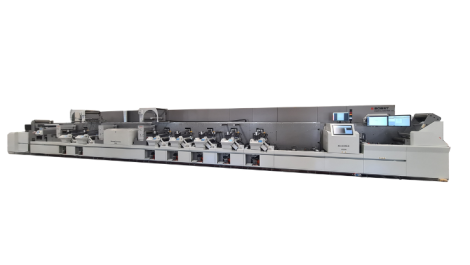(L-R) Trevor Smith, Andrew Degnan, Sean Smyth, Stuart Kellock and Steve Lakin.
Early in December, DL&P invited several converters and brand owners to participate in a round table discussion el industry, and developments into new packaging applications. Despite the arrival of the first winter snow we enjoyed a healthy debate on how the sector is faring, and how it is changing.
The round table event, kindly sponsored by HP, featured Syd Reading of Readyprint, Robert Lee from Tamar Labels, Trevor Smith from Amberley Labels, Stuart Kellock from Leicester based Label Apeel, Andrew Degnan, process development manager of Chesapeake and Paul Jenkins, managing director of PackHub, a company helping innovation in packaging for brands and converters. Also attending were Ester Takacs, packaging manager at Quorn Foods, Steve Lakin and Julia Cole from HP Indigo with Marie Rushton, Rob Mulligan and Sean Smyth of DL&P who chaired the event.
What do brands need?
This year has proved to be very fruitful for the launch of significant new technology, poised to offer fresh opportunities for converters to provide new services. Ester Takacs described how Quorn is exploring new digital flexible packaging (working with Shere Print in Grimsby which is promoting its new digital flexible packaging capability). One concern is problems in matching special brand colours accurately, with the solid and tints of the Quorn orange difficult to render out of CMYK, and the difference in quality between flexo and digital. The digital print is sharper and more vibrant than much of the existing flexo print.
This has been a common issue in the label side, experienced converters often pushing the quality improvements and consistency as an advantage of digital production. Ultimately it is a relationship between supplier and customer, where the expectations need to be managed and there is need for two way education or the capabilities of specific print process. With good colour management, control and substrates digital printing offers more consistency and control, but the process has to be managed properly with the effect of coatings, adhesives and lamination taken into account.
Colour matching is a common, long standing issue. As brands go through redesigns the brand owner, designer and converters will sit together and discuss the design. It is difficult for a converter to admit there will be difficulties in matching colours so they agree to the specification to win work. Then the production starts and the range of materials (including corrugated shelf ready secondary packaging in the case of Quorn). The launch of cloud based colour management, such as the PantoneLive system, may be helpful for the bigger brands to manage colour in an on-going way, but the reality for many brands is that colour standards drift today.
Brand owners are looking for help in lead time reduction, and producing short runs including physical mock ups that are used by many supermarkets as part of their acceptance and testing of new products. These can be a major headache and expense for the brands, with many mock ups produced using ‘Blue Peterish’ techniques, just so a technician can do a scannable test, then consign the mock up to the bin. These merchandising exercises currently involve much effort, the current supply chain demands acceptance by a certain date or the product will not be stocked, digital production will support these requirements.
What do consumers want?
Paul Jenkins raised the question about what it is that consumers want, with more versioning and promotion giving rise to more sales. The example of the Royal Jubilee was discussed, with the logos freely available while for the Olympics there was significant cost in using their branding. While the Royal Mail could release a versioned stamp of all UK gold medal winners in 24 hours there was no similar examples in the packaging or label field. The use of more versioning, eg the Unique Absolut Vodka launch where four million bottles, each uniquely decorated and labelled, were produced. This engaged with its customers and created interest in the brand. In labels the example of L’Oréal shampoo, versioning with various Toy Story, and other DreamWorks, film characters were successful.
Although the individual labels had a significantly higher unit price there were savings throughout the supply chain meant it difficult. Today few designers fully understand the capability of new digital technology, there is responsibility on the technology providers and converters to get the messages of the new capabilities across to packaging specifiers.
The label sector has greatly benefited from the creativity and innovation from the converters and printers using digital technology. They are closer to the market and often see opportunities that develop into great business. Stuart Kellock commented that while they thought having digital capacity would lead to a great growth in very short run production they now have a regular job, reprinting every couple of months for 60,000 linear metres. There is variable data and the customer is delighted with the digital solution but this type of job was not originally envisioned as part of the work mix. His company is now actively seeking other, similar new opportunities.
The issue of security was discussed. While many organisations discuss the requirements the practical take up among our group was very low. Even in pharmaceutical, where Chesapeake has developed and is offering a range of overt and covert features the practical experience was few customers were prepared to pay additional costs. One example was for a Malaria drug on sale in India. Each pack had a unique code printed on it at the gluer, the user texted this code at use and received verification that the pack was genuine but these cases remain quite rare, usually with bottle and batch numbering for tracking the level of identification.
The benefit to both customer and converter that is sustainable is to add more value to labels, this will also be the case in packaging as flexibles and carton production proceeds to use digital production. While the printing is simpler and there are no separate plate costs, Trevor Smith of Amberley described how his company has moved one large customer away from the traditional costing model, eliminating plate costs and providing a simple matrix costing approach. While the overall value was maintained the one-off costs of making small changes, for example different ingredients, was included without any unexpected charges that were not in the customer’s budget. This approach led on to a discussion about digital finishing. None of our converters are using laser cutting, the quality is still felt to be questionable for high speed label applicators, particularly for some synthetics. The other impact is there are reductions in tooling costs for new mechanical dies, possibly as a result of pressure from the new digital cutting technology on the market. All agreed that finishing is a key part of the value add and this more complex finishing meant high set up times to convert the printed labels with foiling, coating and lamination and embossing all becoming more common. Chesapeake is about to undertake a rigorous testing of the new digital cut and crease system from Highcon. Much of this will be for pharmaceutical cartons where Braille is a key requirement.
Market opportunities
The requirement for changeable shape cartons was identified as a market opportunity, where the crease pattern is maintained but the complexity of cuts can be grater with digital cutting, so there may be an Easter Bunny shape at Easter and a Santa cut out on the same basic box to maintain performance and reduce set up changes at packing/filling stages, but create more interest in the pack to attract consumer attention.
One problem that is now apparent is the process to instigate and approve changes in shape or design for many bigger brands with many stakeholders. Catching the attention of customers is paramount; the digital tools are well suited for this. Several converters commented that they had great success with small brands, for example micro-breweries and craft foods. Here digital allows these smaller customers to now have extremely high quality, complex labels and packs that show very well against the market leaders and ‘punch above their weight’. The small companies were much quicker in decision making and approvals. The impact of a small amount of extra pick up, from more sales, in regional supermarkets can be great for these companies. A suitable digital label can really change the whole fortunes of such companies if successful.
My final question to the label converters was should they look at new products (cartons and flexibles) on their digital presses. The majority already had broadened the products, with one dissenting voice saying they were happy to concentrate on labels and leave new fields to the specialists. As digital packaging takes off many of the skills are transferable, putting existing converters into a good market position. So, the overall message was ‘welcome to a new, exciting, world’.






